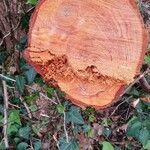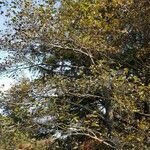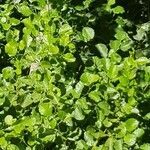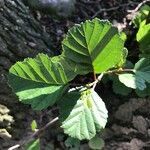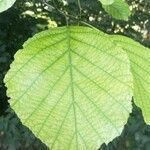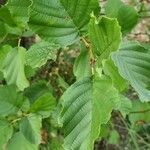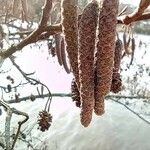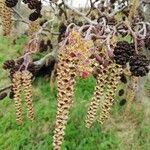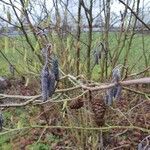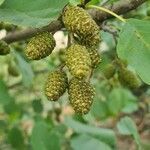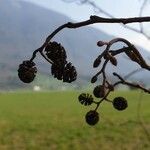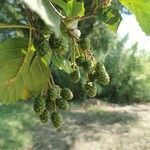Tree to c. 15 m high (to c. 20 m in cultivation). Bark dark brown, strongly fissured. Young shoots glabrous but glandular-viscid. Winter buds short-stalked, purplish. Petiole 7-15 mm long, often purplish. Lamina 4-10 × 2.5-10 cm (to 14 × 13 cm on vigorous vegetative shoots), broadly oblong to obovate, plicate in bud, hairy on veins beneath at first, soon glabrous except for tufts of axillary hairs, serrulate to coarsely serrate, lobulate on basal vegetative shoots; veins in 6-7 pairs, prominently raised beneath; base usually cuneate; apex rounded to retuse. Buds stipitate, not enclosing ♀ catkins in winter. ♂ catkins 3-8 together behind shoot apices, 2.5-7 cm long (to 12 cm in cultivation), cylindric, opening in spring before lvs; peduncles to c. 5 cm long; bracts peltate, purplish; anthers yellow. ♀ catkins 3-7 together behind shoot apices, c. 5 mm long, glandular. Cone (1)-1.3-1.7-(2) cm long, ellipsoid; scales becoming horizontal after dehiscence and persistent on tree. Nutlet c. 3 mm long, broadly ovoid; wing narrower than nut.
Tree, with young parts very glutinous; lvs broadly oval to obovate or subrotund, broadly rounded above or retuse, broadly cuneate to rounded at base, finely serrate, with 5–8 principal veins on a side; fruiting catkins very glutinous, evidently pedunculate in axillary infls, 1.5–2.5 cm, 10–13 mm thick; frs elliptic or suborbicular, 2.5–3.5 mm, narrowly bordered; 2n=28. Native of Eurasia and n. Afr., planted especially along roadsides and occasionally escaped in our range. (A. alnus; A. vulgaris)
Tree, 20-30 m high; young growth glutinous; monoecious. Leaves petiolate; blade elliptic to broadly ovate, 60-120 mm long, apex truncate, base cuneate, margins shallowly toothed, sticky when young, later glossy green; petiole up to 50 mm long. Flowers: male catkins 50-100 mm long, pendulous, reddish; female catkins 200 mm long, dark brown to black; Nov.-May. Fruit cone-like with 5-lobed scales, persistent; nutlets winged.
Pending.
A tree.
